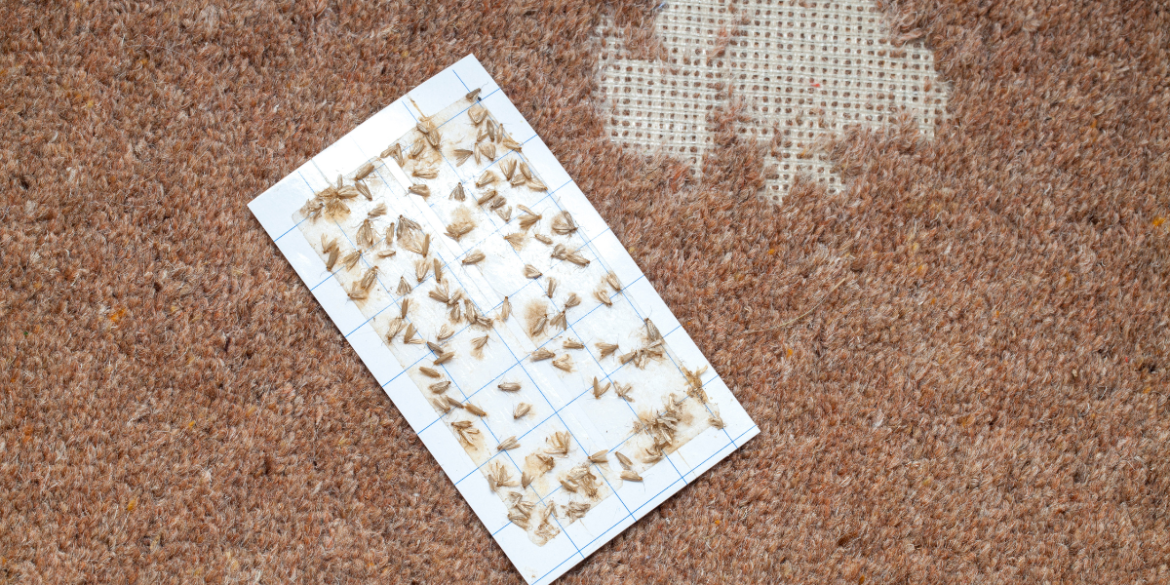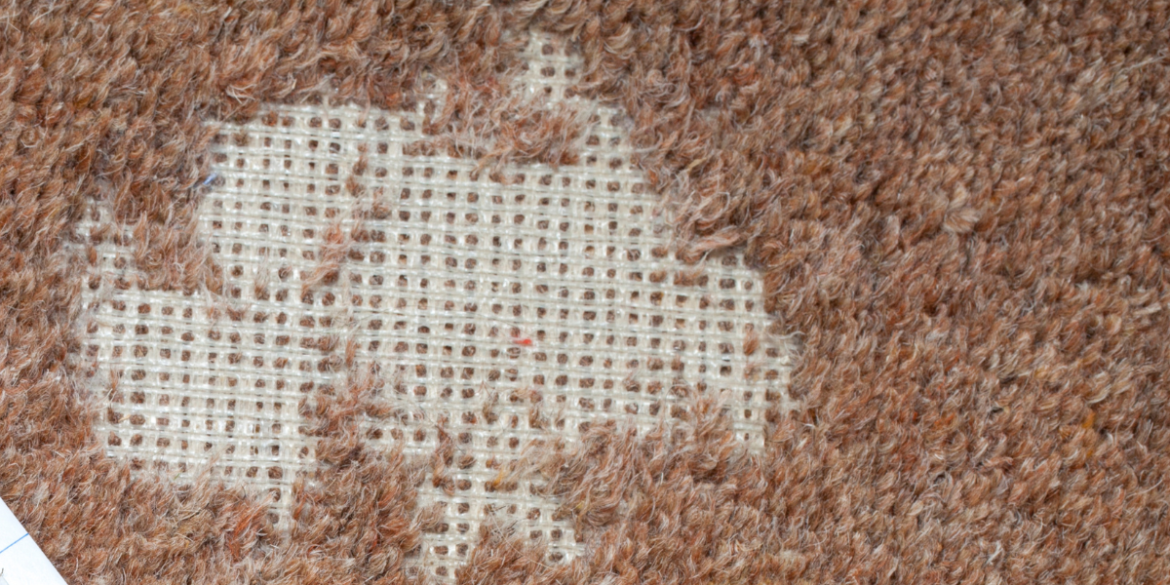Cleaning
How to get rid of carpet moths for good
If you’ve noticed some carpet moth damage to your carpets and rugs or have seen signs of actual carpet moths, then it’s time to learn how to identify them and know the best way to get rid of them. In this blog post, we will look at the facts you need, including what a carpet moth infestation looks and smells like, where they come from, how much damage they cause, and finally, provide ten simple tips to help you get rid of carpet moths once and for all!

What are carpet moths?
Carpet moths are a common nuisance that infests many homes.
A single female moth can lay up to 200 eggs in its lifetime, meaning an infestation can quickly spread and cause even more damage if it’s not treated promptly. Carpet moths are often mistaken for flies due to their size and fluttery appearance. However, the moth lays eggs in carpets and other soft furnishings. The carpet moth larvae feed on the carpet’s fibers when the eggs hatch, leading to unsightly bare patches and holes.
How do carpet moths get in your house?
Carpet moths can enter your home in various ways. They may come in through open windows or doors, be brought in on pets or other animals, or hitchhike their way into your house on furniture or clothes from the outdoors. Carpet moths can also come in with secondhand furniture or clothing.
How to identify carpet moths
Carpet moths are a common pest in many homes and businesses. Identifying them can be tricky, but there are several steps you can take to identify carpet moths in your home or commercial building.
The larvae of carpet moths create a sticky, web-like layer around themselves, which helps to trap dust and other materials. This layer protects from predators until the larvae develop into adult moths with fully developed wings and legs.
In addition to consuming textiles, carpet moths can leave behind unsightly webbing and droppings, spoiling the appearance of floors and fabrics.
With their rapid breeding and hardiness, carpet moths pose a real threat to the home, making it important to watch for the signs of infestation and take action at the first signs.
There are a few types of carpet moths, so it is important to tell them apart. The most common types of carpet moths are case bearing moths, webbing clothes moths, and brown house moths. Each type has a distinct appearance that can help you determine which one is causing your infestation.
- Case bearing moth has a round, off-white body and forewings with three dark stripes.
- Webbing clothes moth: is small and golden in color with three dark spots near the head.
- Brown house moth: is light to medium brown and has pale yellowish edges on its wings.
Signs of a carpet moth infestation
It can be tricky to spot a carpet moth infestation as the moths are not visible. However, some signs can indicate their presence. These include:
- A musty smell that may become stronger over time, small holes in carpets, rugs, or fabrics, and the presence of larvae or their skins.
- Check for larvae webbing on carpets and upholstery seams, which can provide a hiding place for moths.
- Carpet moths feed on natural fibers like wool and silk, so look for missing fibers and small, moth-like insects flying around your home.
- Early detection and treatment can prevent further damage to your home and belongings.

This post contains affiliate links, and The Organizer UK may earn commissions for purchases made through the links in this post. For more details, see here. Thank you so much for your support!
How to get rid of existing carpet moths
Carpet moths can be a real nuisance and can cause damage to your carpets and furniture if left unaddressed. If you’re dealing with an infestation, there are several steps you can take to get rid of carpet moths.
Keep carpets clean.
First, vacuum your carpets thoroughly, particularly in areas where moths might hide, such as under furniture, along baseboards, and in closets.

Take care not to reinfest your home.
Be sure to empty your vacuum outside and dispose of the contents as soon as possible, as the moths may still be alive and can reinfest your home. Afterward, wipe down all surfaces with a damp cloth to collect hairs or debris. Vacuum attachments can be helpful in hard-to-reach spaces. Carefully inspect your furniture, carpets, rugs, and curtains for moths or larvae. If you find evidence of infestation, use a vacuum cleaner to suck up any larvae or moths.
Deep clean your carpet.
Next, deep clean your carpets using a steam cleaner like this one, or hire a professional carpet cleaning service. This will help remove any food particles and dust mites, which can attract moths.
Use a water-based moth spray.
You can also try using a water-based moth spray like this one, which will penetrate deep into the carpet fibers and help keep moths away for months. Follow the instructions on the bottle and keep pets away from any areas you have treated.
Launder fabrics on the hottest setting.
Carpet moths can lay their eggs in any fabric. Washing fabrics like bedsheets in hot water and high-temperature drying can kill existing moth eggs or larvae. However, note that some fabrics should not be washed in hot water. So check the care-label instructions before washing or drying your clothes.
Store clothes in plastic containers.
It’s also a good idea to keep clothing and other fabrics stored away in airtight containers made of plastic like this one or rubber to help reduce the risk of moths spreading throughout your home.
Try using an insect fogger.
Additionally, you can use an insecticidal powder or fogger like this one to help deter moths from entering your home and damaging your clothing.
Make sure your home is well-ventilated.
Proper ventilation is also essential, as moths thrive in moist environments. To find out how to air out your home, read this post.
Try professional help.
Finally, if you are having difficulty getting rid of carpet moths, consider contacting a pest control professional to help you remove carpet moths and prevent future infestations. They will be able to advise you on the most effective treatment methods and how to keep your home safe from future infestations.
Prevention tips to keep carpet moths from entering your home
To prevent carpet moths from entering your home:
- Vacuum your carpets and soft furnishings regularly and use insecticides and repellents if necessary.
- Examine new items for signs of carpet moths, such as larvae or webs around fabric fibers.
- Frequently wash clothes and fabrics at high temperatures to prevent moth infestations.
- Fix potential entry points for the insects, such as torn window screens or broken door seals.
- Protect hardwood floors by using a cleaner specifically designed for them.
- Place sticky moth traps like these in drawers or corners where moths can hide.
- Regularly inspect your items for new damage.
- Keep windows and doors closed.
- Check clothing before storage.
DIY solutions for removing carpet moths
Fortunately, there are a few DIY options for removing carpet moths that can help you take control of the moth problem.
- One popular method is using natural repellents like lavender, cedar, or eucalyptus to discourage moths naturally from infesting carpets.
- Another option is to vacuum regularly, focusing on the areas where moths are most likely to congregate.
- You may need professional pest control services for severe infestations to tackle the problem.
FAQ about carpet moths
Can carpet moths live in floorboards?
Yes, carpet moths can live on floorboards. The moth’s larvae can feed on organic fibers found in wood, fabric, and upholstery. This means that they have the potential to inhabit any location where these materials are present, including beneath carpets and even inside cracks or crevices within floorboards. Adult carpet moths typically lay eggs in dark, undisturbed areas, dust, and lint-filled carpets. Keeping floorboards and carpets clean and vacuumed regularly is important to prevent a carpet moth infestation. Additionally, you can use an insecticidal powder or fogger like this one to help deter them from entering your home.
What is a carpet moth cocoon?
A carpet moth cocoon is a protective shell created by the larvae of carpet moths. This cocoon typically has a sticky, web-like layer around it that traps dust and other materials to help protect the larvae from predators. The larvae eventually emerge from the cocoon as adult carpet-eating moths with fully developed wings and legs. Most bearing clothes moths spin a cocoon for protection.
Do carpet moths eat clothes?
No, carpet moths do not eat clothes unless made from natural fibers such as wool, silk, fur, and feathers. Carpet moths lay their eggs inside these materials, and the larvae will then feed and develop within them. In rare cases where they may be exposed to synthetic fabrics, carpet moth larvae may be able to damage these materials. However, this is unlikely and usually only occurs if a large infestation of carpet moths is present.
Does vinegar kill carpet moths?
Yes, vinegar can be an effective way to kill carpet moths. It can be used as a homemade insecticide by mixing one part white vinegar and one part water in a spray bottle and applying it directly to the affected area. The acidic nature of vinegar is toxic to moths and larvae, but it is important to note that this method may not reach deep enough into carpets to eradicate the infestation. To ensure the complete removal of carpet moths, it is best to call a professional extermination service. They will be able to assess the extent of the problem and provide advice on how best to remove the pests safely.
In conclusion, carpet moths can be nasty pests, and every homeowner needs to know how to identify them and the steps necessary to remove them from their home. Following the prevention tips above is important to reduce the risk of a carpet moth infestation. Furthermore, various DIY solutions can help people remove existing carpet moths from their homes. Learning and implementing these techniques in your home will help protect your family and belongings from damage and unsightly infestations of carpet moths. Congratulations on learning about how to get rid of carpet moth infestations! Don’t miss out on our updates for expert housekeeping tips to keep your home safe and beautiful.

